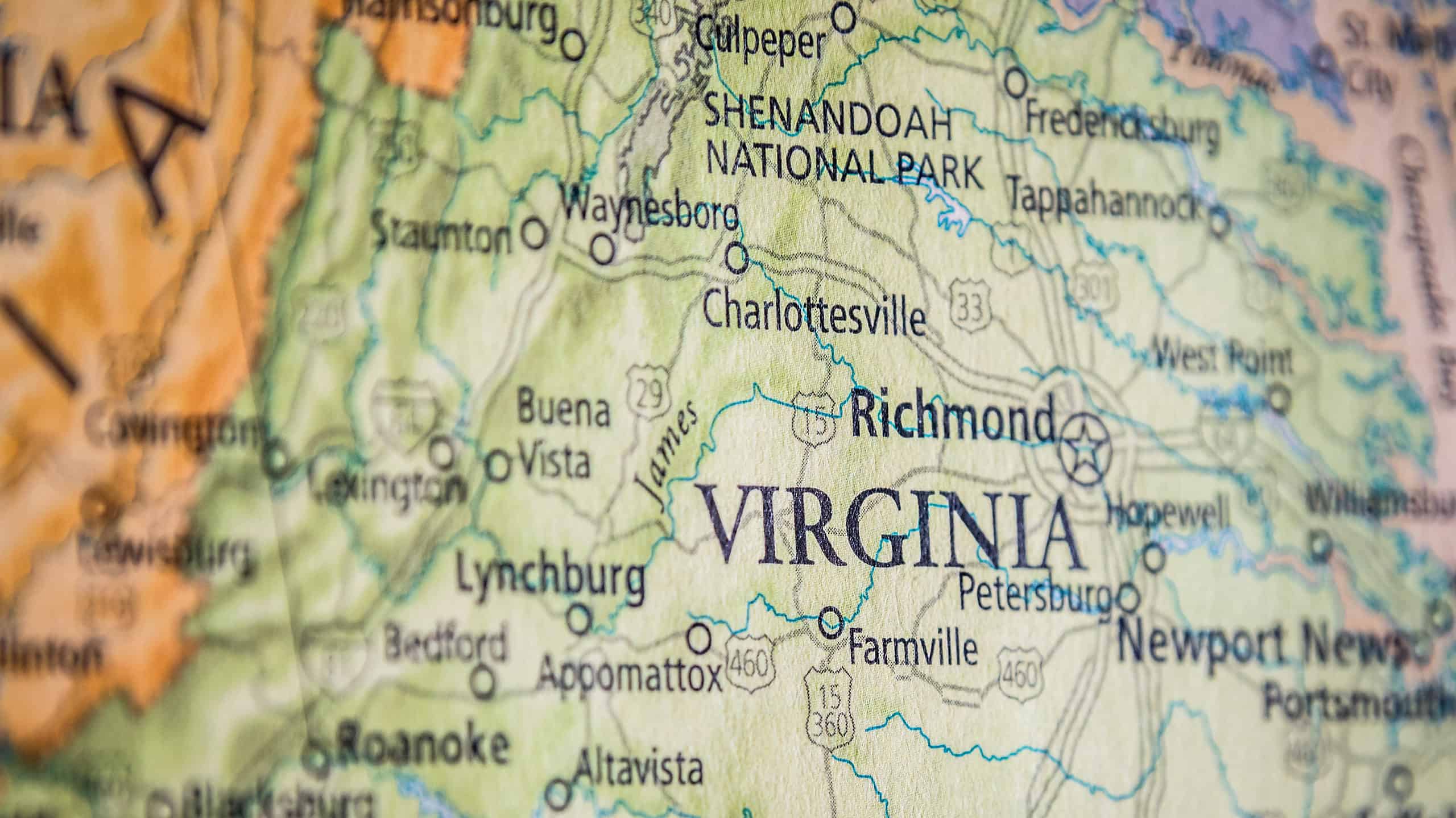
Officially named the Commonwealth of Virginia, Virginia has some of the most beautiful national parks in the country.
©BestStockFoto/Shutterstock.com
Virginia has some of the most beautiful national parks in the country. This state is home to the Appalachian Mountains, fertile grasslands, deciduous forests, and even coastal beaches. It’s no wonder why there are so many different types of snakes in Virginia when you think about how many different types of habitats there are for snakes and other wildlife.
Every year millions of people take advantage of the gorgeous landscapes and sultry weather in Virginia to go hiking, fishing, camping, boating, kayaking, and more. When you’re outdoors enjoying all the great outdoor activities that Virginia offers make sure that you are also watching out for these common snakes in Virginia.
Discover 24 Snakes in Virginia
Some of the most common snakes that you’ll find in Virginia are:
Northern Scarlet Snake
You may recognize this snake right away, or think you recognize it. That’s because the northern scarlet snake looks like several other snakes known for having wide bands. This snake looks like a non-venomous milk snake and a California mountain king snake.
And it also looks like a venomous coral snake even though the northern scarlet snake is not venomous. You can immediately tell that the northern scarlet snake is not venomous because it has black bands right next to the red bands. Any snakes that have those tell-tale red bands bordered by black is not venomous. The venomous coral snake has yellow bands right next to the red bands.
Northern scarlet snakes like to burrow in loose sandy soil and in Virginia, you will find them mostly in the coastal region.
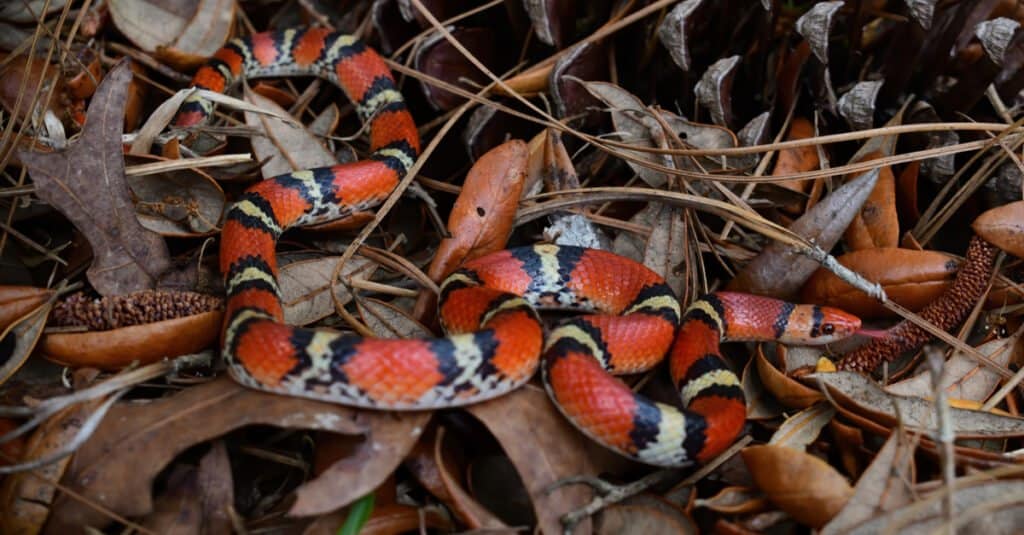
Northern scarlet snakes like to burrow in loose sandy soil and in Virginia you will find them mostly in the coastal region.
©Chase D’animulls/Shutterstock.com
Ring-Necked Snake
Ring-necked snakes are very small. Some of them are only 10 inches long! And even the larger ones are less than two feet long. They are typically a dark olive or bluish-gray color with a bright yellow ring around the neck. Northern ring-necked snakes have a solid ring around their necks while Southern ring-necked snakes have a ring that is broken in several places. Ring-necked snakes are very common in Virginia because they can thrive in a range of habitats. You can find them all the way from the Appalachian Plateau to the Coastal Plain.
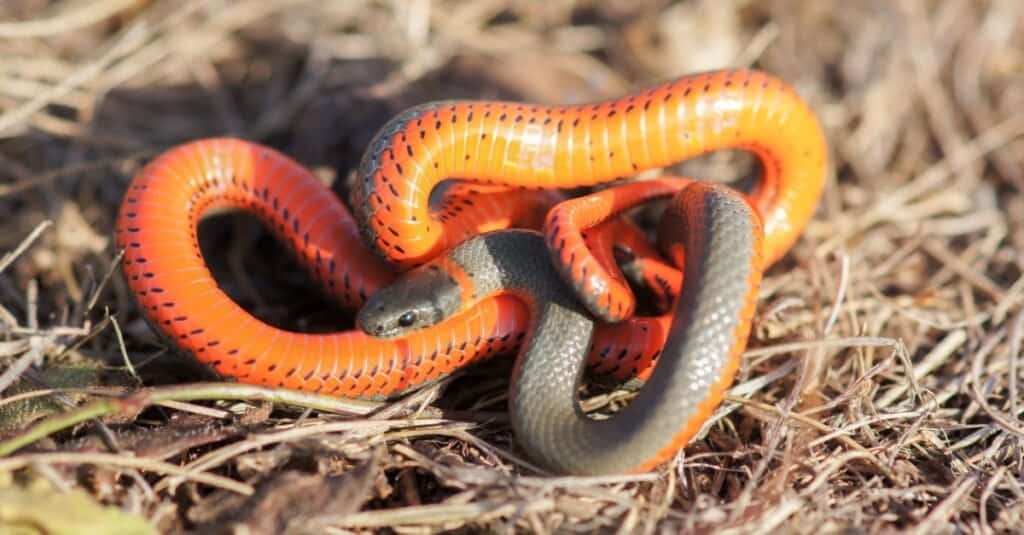
Ring-necked snakes are very common in Virginia because they can thrive in a range of habitats.
©yhelfman/Shutterstock.com
Eastern Mud Snake
Eastern mud snakes have a striking color pattern that makes them really stand out. In Virginia, you can find eastern mud snakes primarily in the east and southeast parts of the state. These snakes are usually between four and five feet long. They have black bodies with bright red bellies which is why they are sometimes also called red-bellied snakes.
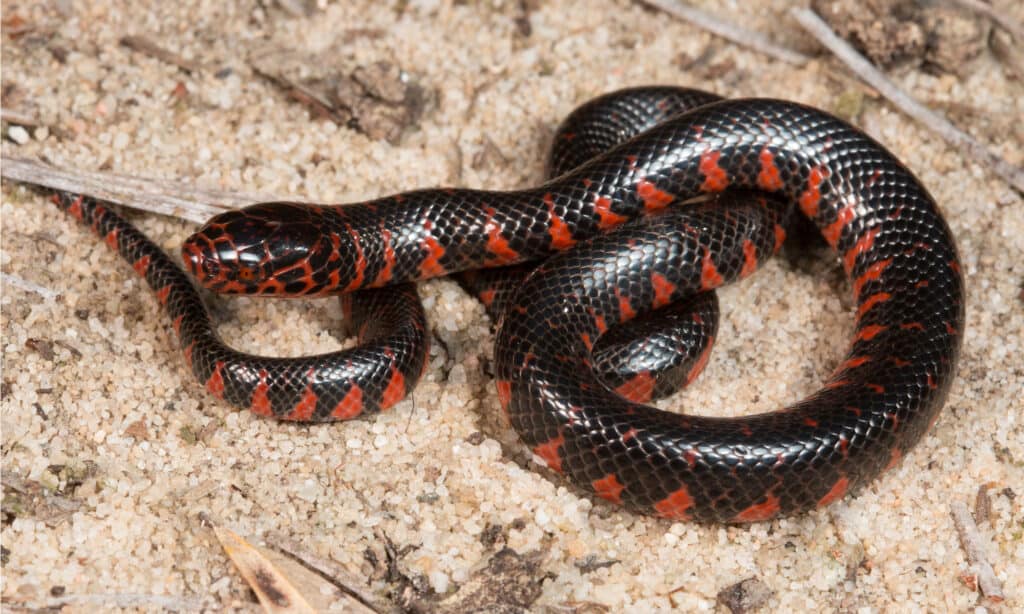
In Virginia, you can find eastern
mud snakes
primarily in the east and southeast parts of the state
©Nathan A Shepard/Shutterstock.com
Northern Mole King Snake
The northern mole king snake lives throughout Virginia. Anywhere that you find grassy areas or forested areas you find the northern mole king snake. These snakes are usually tan or brown and not very long. The average length of a northern mole king snake is just between 30 and 40 inches. You will sometimes see these snakes in suburban areas hiding in mulch or leaf litter or along the edges of garages and outbuildings. Northern mole king snakes in Virginia are very common, especially in the Appalachian Mountain region.

The northern mole king snake lives throughout Virginia in grassy areas or forested areas.
©Krumpelman Photography/Shutterstock.com
Eastern Milk Snake
The eastern milk snake may be confused with the northern scarlet snake because the two have very similar color patterns. Both have bright red bands surrounded on each side by black bands. However, the eastern milk snake is primarily found in the western part of the state not in the coastal region like the northern scarlet snake. Eastern milk snakes are between two and three feet long. Both the eastern milk snake and the northern scarlet snake mimic the colors of the venomous coral snake, but neither of these snakes is venomous. There are no coral snakes in Virginia.

The eastern milk snake is primarily found in the western part of Virginia.
©Seregraff/Shutterstock.com
Red Corn Snake
Red corn snakes are very common in Virginia. They live in more than 44 counties around the state and many have been spotted in the areas near Richmond, Roanoke, and Salem. These snakes tend to be between three and four feet long. They have a very bold distinctive red and red-orange color pattern. But you will most likely not see a red corn snake even if you are very close to one. They are extremely secretive snakes and prefer to burrow into the soil rather than risk a confrontation with people or predators. If you do happen to see one don’t worry. Despite the scary appearance, these snakes are harmless to humans.
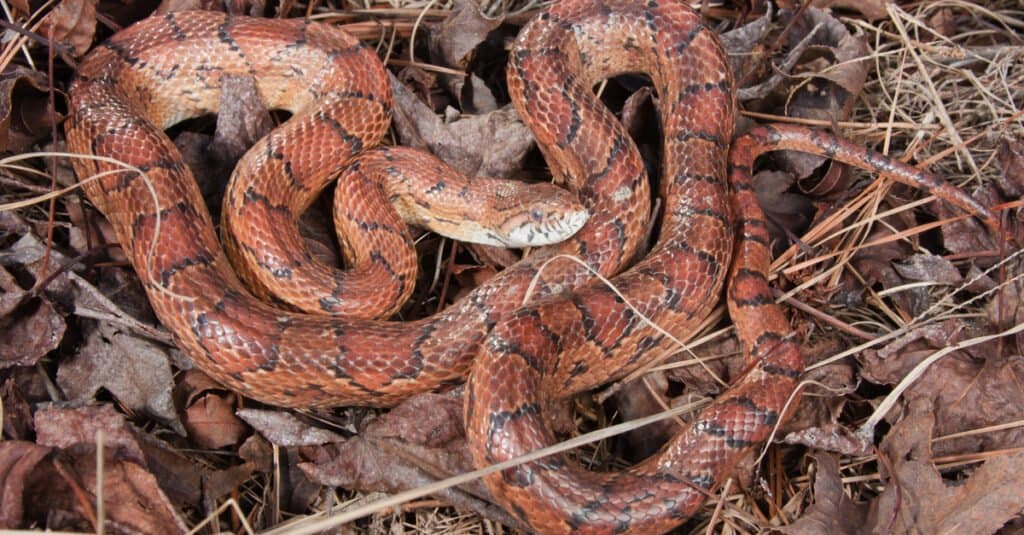
Red corn snakes are very common in Virginia and present in more than 44 counties.
©Nathan A Shepard/Shutterstock.com
Water Snakes in Virginia
Virginia has a lot of water snakes, which isn’t really a surprise when you consider the geography and climate of Virginia. That means there are also a lot of water snakes in Virginia that are attracted to the fish and other animals that live in the water. The water snakes in Virginia are:
Northern Water Snake
Northern water snakes are the most common type of water snake that you’ll see in Virginia. They can be found enjoying the many lakes and rivers scattered throughout the state. Often you will see them sunning themselves on rocks in the middle of the water. They are large and slow. Typically northern water snakes are anywhere from two feet to about five feet long.
Their color patterns vary based on where they are living because their colors are designed to help them blend into the water and foliage around them. Some are more brown and olive colors while others are gray and other are black or dark brown. Often the northern water snake is mistaken for the cottonmouth snake. But the northern water snake is not venomous like the cottonmouth snake.
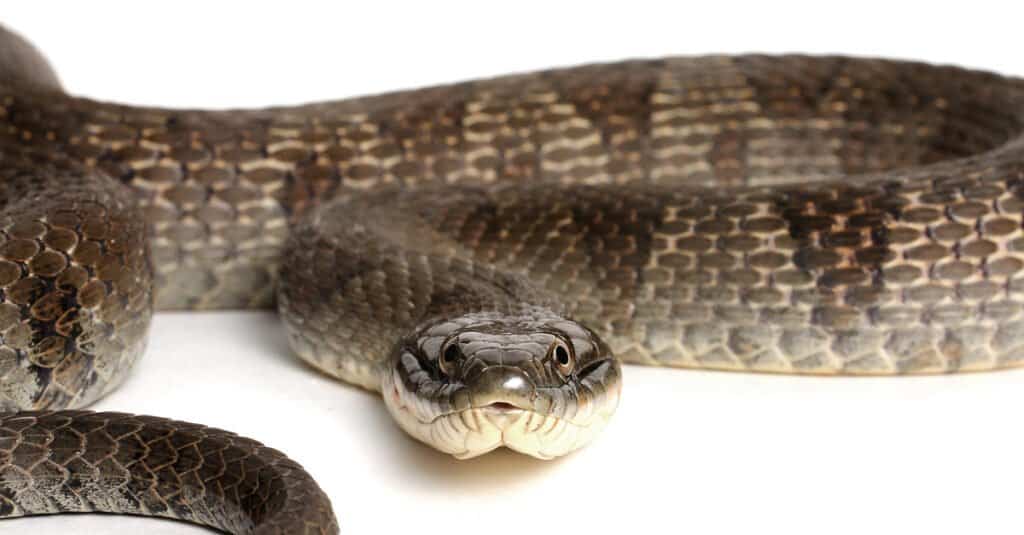
Northern water snakes are the most common type of water snake that you’ll see in Virginia.
©Michiel de Wit/Shutterstock.com
Northern Cottonmouth
The northern cottonmouth snake is one of the three venomous snakes in Virginia. They are water snakes that are typically found near lakes or in the coastal region of the state. Be very careful if you see a snake that you think might be a Cottonmouth because they are a little belligerent. And they can hurt you if they bite you. Cottonmouth snakes are about three feet long usually and have brown or black bodies with brown markings. But the way you can tell if a snake on the water is a northern water snake or a northern cottonmouth is to look at the snake’s mouth. Cottonmouth snakes have white patches around and in their mouths.
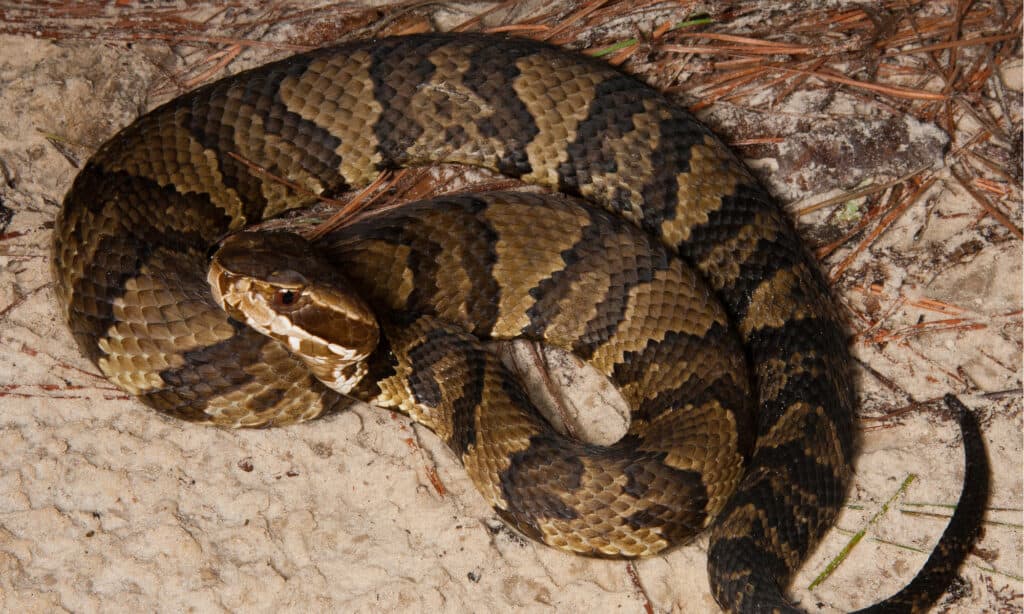
The northern cottonmouth snake is one of the three venomous snakes in Virginia.
©Nathan A Shepard/Shutterstock.com
Plain-Bellied Water Snake
Plain-bellied water snakes prefer rivers, marshes, and flood plains so you can typically find them in the coastal region of Virginia although they have also been spotted near Appalachian mountain streams. These snakes are usually about 40 inches long. The top of the plain-bellied water snake is one solid color, usually olive, brown, or gray.
The bellies of these snakes are yellow, cream, or sometimes red and are all solid with no markings. Plain-bellied water snakes spend about as much time on land near the water as they do in the water so if you’re fishing or kayaking keep a close eye out on the area around you when you’re at the edge of a stream or lake. There may be a plain-bellied water snake hiding there. These snakes are not venomous though so they will not hurt you.
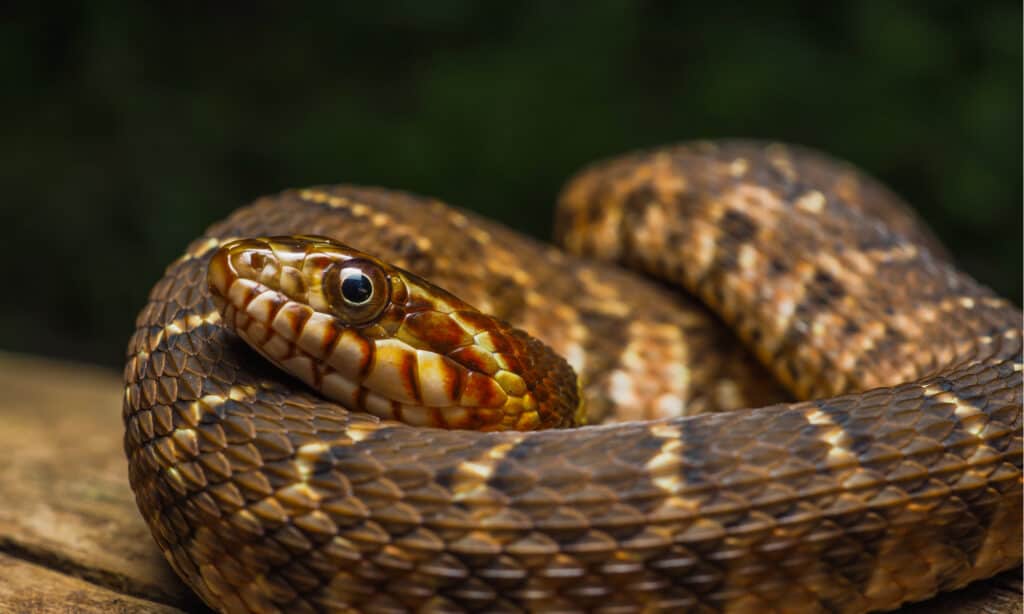
Plain-bellied water snakes prefer rivers, marshes, and flood plains.
©Tyler Albertson/Shutterstock.com
Brown Water Snake
Brown water snakes like aquatic environments that have a lot of cover and foliage. That’s why typically they live in marshlands and wetlands, on the flood plain, and in the swamps. You will also sometimes see them near rivers that run through forested areas. These snakes are the longest water snakes in Virginia and can be up to about 60 inches long.
They have thick bodies and their coloration is usually brown or tan with dark brown or black markings to help them blend into the water and the vegetation around the water. If you like to fish you will likely see brown water snakes hanging out at the edge of the water so be careful that you don’t surprise them.
Brown water snakes are not venomous, but any snake can strike out if you surprise it or make it feel cornered. As a general rule of thumb move slowly when you’re walking in the vegetation on the edge of a lake or in the swampy marshlands so that you don’t startle a brown water snake.
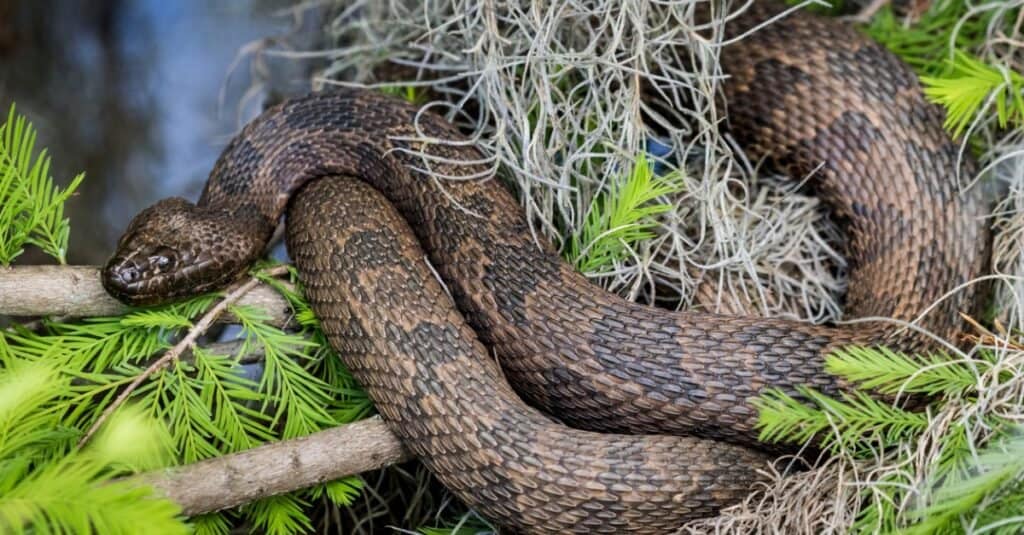
Brown Water Snakes are the longest water snakes in Virginia and can be up to about 60 inches long.
©iStock.com/csraphotography
Queen Snake
Queen snakes are mostly found in the southwest and western parts of Virginia. They are usually about two feet long. Rarely are they longer than about two and a half feet long. The color patterns for queen snakes vary between olive and tan with cream or yellow stripes down the sides of the body. Queen snakes prefer to live in lakes and streams or in the vegetation directly next to the water. Their primary food is crayfish.

Queen snakes are mostly found in the southwest and western parts of Virginia.
©Jason Patrick Ross/Shutterstock.com
Venomous Snakes in Virginia
Even though Virginia only has three types of venomous snakes these snakes are found throughout the state. You should always be careful and be on the lookout for any venomous snake. Most of the time snakes aren’t going to bite you, but if you surprise a snake or if you come up on them and make them feel cornered they may bite. Rattlesnakes will almost always rattle first to let you know that you need to back up. But it’s still best to pay attention and never put yourself in a position where you will run across one of these venomous snakes in Virginia:
Eastern Copperhead
Eastern copperhead snakes are venomous and can be very dangerous. They are found all over the state so always be careful and keep a sharp eye out for these snakes. Copperheads are usually only about three feet long but they can get bigger. The longest copperhead rattlesnake ever recorded in Virginia was a whopping 48 inches long.
You can instantly recognize a copperhead rattlesnake by their very unique red coppery color and their brown and tan markings. The rattle is also a dead giveaway. But if you’re close enough to a copperhead snake to hear it rattle then you need to start backing up very slowly and get out of there.
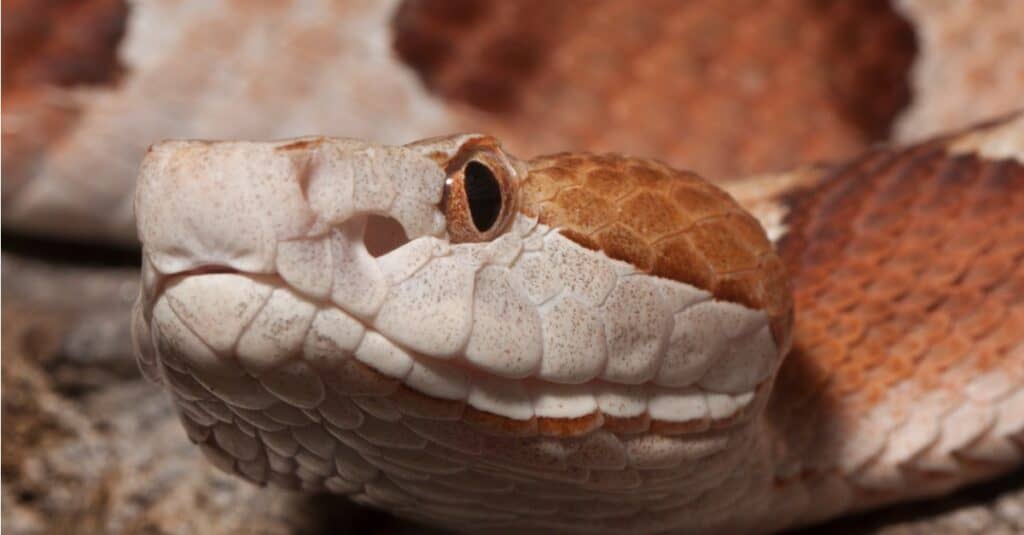
Eastern copperhead snakes are venomous and can be very dangerous.
©iStock.com/Mark Kostich
Northern Cottonmouth
As previously mentioned the cottonmouth snake is one of the water snakes that Virginia is known for. It’s the only venomous water snake and is found in the southeast, especially in Virginia Beach and Chesapeake.
Timber Rattlesnake
Timber rattlesnakes are found primarily in the southwestern part of the state. They like the rocky outcroppings and ledges typical of the mountain regions in Virginia. These venomous snakes are the longest venomous snakes in the state. They can be up to 60 inches long. Timber rattlesnakes are usually a mix of tan, brown, and black depending on their surroundings. They prefer not to be seen, but if you do come across one move slowly and carefully. A timber rattlesnake usually won’t strike unless it feels threatened.
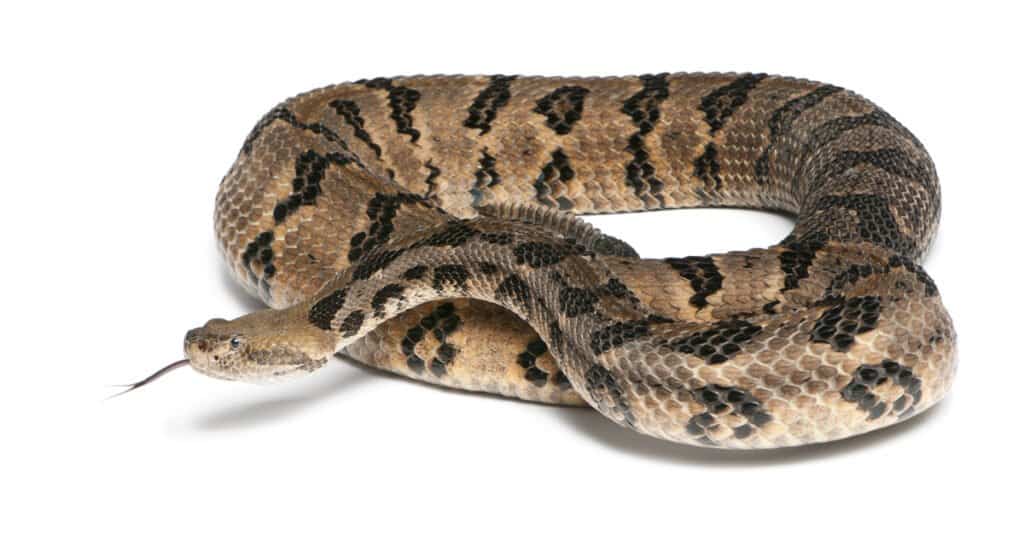
Timber rattlesnakes are found primarily in the southwestern part of the state.
©Eric Isselee/Shutterstock.com
Summary of 24 Snakes in Virginia
Here’s a recap of species of snakes present in Virginia that we’ve taken a close look at:
| Number | Snake | Location |
|---|---|---|
| 1 | Northern Scarlet Snake | Coastal region |
| 2 | Ring-Necked Snake | Appalachian Plateau to the Coastal Plain |
| 3 | Eastern Mud Snake | East and southeast |
| 4 | Northern Mole King Snake | Throughout Virginia, especially in the Appalachian Mountain region |
| 5 | Eastern Milk Snake | Western Virginia |
| 6 | Red Corn Snake | Very common; in more than 44 counties |
| 7 | Northern Water Snake | Throughout Virginia |
| 8 | Northern Cottonmouth | Near lakes or in the coastal region |
| 9 | Plain-Bellied Water Snake | Coastal region |
| 10 | Brown Water Snake | Marshlands, wetlands, swamps, on the flood plain |
| 11 | Queen Snake | Southwest and west |
| 12 | Eastern Copperhead | Throughout Virginia |
| 13 | Northern Cottonmouth | Southeast |
| 14 | Timber Rattlesnake | Southwest |
A Complete List of Snakes in Virginia
The complete list of snakes in Virginia is:
- Eastern Copperhead
- Northern Cottonmouth
- Timber Rattlesnake
- Eastern Worm Snake
- Northern Scarlet Snake
- Northern Black Racer
- Ring-Necked Snake
- Eastern Mud Snake
- Common Rainbow Snake
- Rough Earth Snake
- Eastern Hog-nosed Snake
- Northern Mole Kingsnake
- Eastern Milk Snake
- Eastern Glossy Swamp Snake
- Northern Water Snake
- Rough Green Snake
- Smooth Green Snake
- Red Corn Snake
- Northern Pine Snake
- Queen Snake
- Dekay’s Brown Snake
- Eastern Garter Snake
- Brown Water Snake
- Plain-Bellied Water Snake.
What State Has the Most Snake Bites?

The venomous eastern diamondback rattlesnake is among those responsible for snake bites in North Carolina.
©Chase D’animulls/Shutterstock.com
In Virginia, which ranks 5th for the most snake bites annually per U.S. state, there are an estimated 48.7 bites per million population reported per year. But what state ranks the highest in snake bites? That would be North Carolina. This southeastern state’s bite rate is 157.8 bites per million population per year. How does that average out? Well, the population as of 2021 was a little over 10 million (10.55 to be exact). If we were to just figure it off of 10 million, that would mean that there are roughly 1,580 reported snake bites per year.
The top 6 states for reported snake bites are as follows:
- North Carolina–157.8 bites per million
- West Virginia–105.3 bites per million
- Arkansas–92.9 bites per million
- Oklahoma–61 bites per million
- Virginia–48.7 bites per million
- Texas–44.2 bites per million
In North Carolina, there are 6 different kinds of venomous snakes: copperhead, cottonmouth, timber rattlesnake, pigmy rattlesnake, eastern diamondback rattles
Other Reptiles Found in Virginia
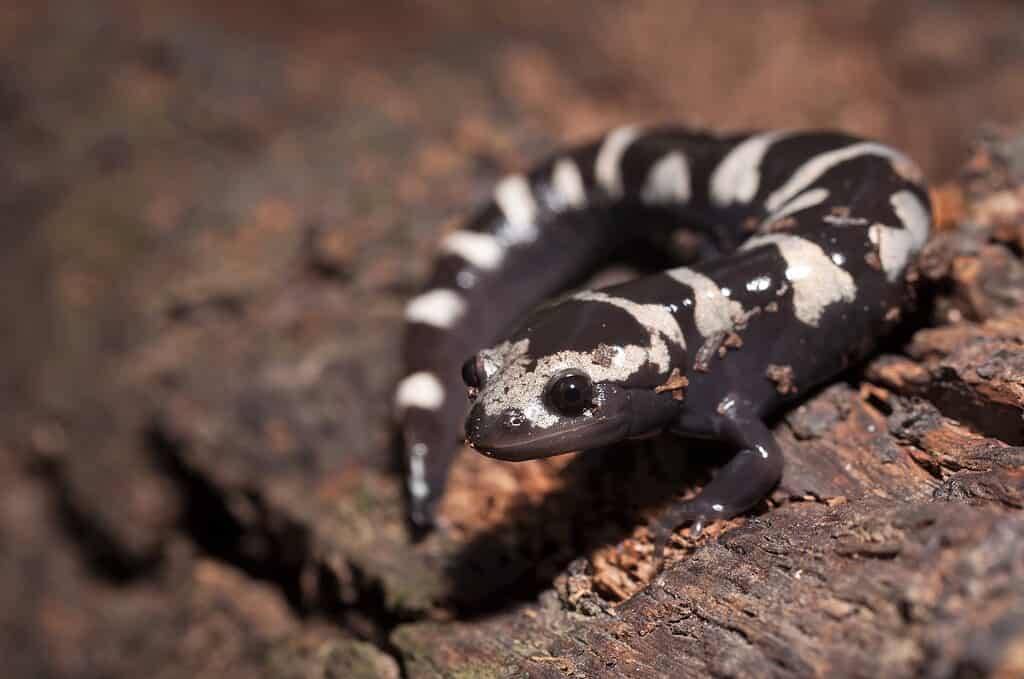
`The marbled
salamander
is nocturnal and as a result, is rarely seen.
©Mike Wilhelm/Shutterstock.com
Virginia is home to 59 different species and subspecies of salamanders and one of them is the beautiful marbled salamander. These reptiles have average lengths of between 3.5 to 4.3 inches and while always black, have varying bands of color dependent on whether they are male (white bands) or female (silvery gray bands). Like many of its species, this salamander has poisonous glands on its tail to protect it from predators but unlike others of its kind, they breed on land.
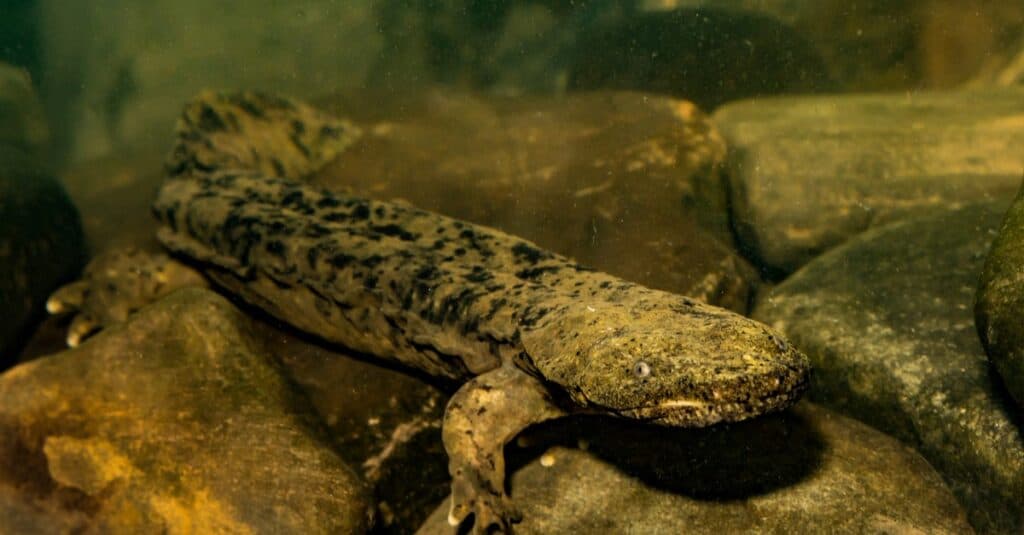
Eastern Hellbenders are listed as an endangered species.
©Jay Ondreicka/Shutterstock.com
Eastern hellbenders are the largest aquatic salamander in North America and can range in size from 12 to 29 inches. It currently has a high risk of extinction, due to the pollution and the damning of rivers and streams, and is protected in numerous states. Although these large reptiles have lungs, they are not very functional but instead breathe using numerous baggy flaps of thick wrinkled skin that run down their sides. These skin wrinkles absorb almost 95% of their oxygen. The Eastern hellbender is not poisonous, but they are opportunistic cannibals and will eat eggs, larvae, and even smaller adults.
The photo featured at the top of this post is © Nathan A Shepard/Shutterstock.com
Discover the "Monster" Snake 5X Bigger than an Anaconda
Every day A-Z Animals sends out some of the most incredible facts in the world from our free newsletter. Want to discover the 10 most beautiful snakes in the world, a "snake island" where you're never more than 3 feet from danger, or a "monster" snake 5X larger than an anaconda? Then sign up right now and you'll start receiving our daily newsletter absolutely free.
FAQs (Frequently Asked Questions)
What makes Virginia a great habitat for so many types of snakes?
Virginia has some of the most beautiful national parks in the country. This state is home to the Appalachian Mountains, fertile grasslands, deciduous forests, and even coastal beaches. It’s no wonder why there are so many different types of snakes in Virginia when you think about how many different types of habitats there are for snakes and other wildlife.
What other snakes are the Northern Scarlet Snake mistaken for?
The Northern Scarlet Snake looks like non-venomous milk snake, California mountain king snake and venomous coral snake.
Thank you for reading! Have some feedback for us? Contact the AZ Animals editorial team.






